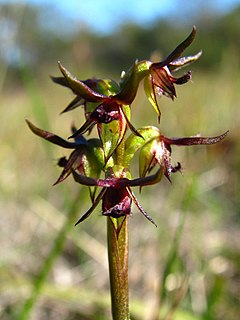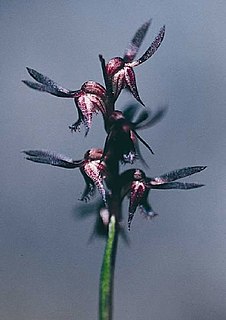
Genoplesium archeri, commonly known as the elfin midge orchid and as Corunastylis archeri in Australia, is a small terrestrial orchid endemic to south-eastern Australia. It has a single thin leaf fused to the flowering stem and up to fifteen small, hairy, yellowish green flowers with purple stripes. It grows in a wide range of habitats in New South Wales, Victoria and Tasmania.

Genoplesium arrectum, commonly known as the erect midge orchid and as Corunastylis arrecta in Australia, is a small terrestrial orchid endemic to south-eastern Australia. It has a single thin leaf fused to the flowering stem and up to twenty small, dark purple flowers. It grows in a montane and subalpine grassland and forest in Victoria and the Australian Capital Territory.
Genoplesium littorale, commonly known as the Tuncurry midge orchid, and as Corunastylis littoralis in Australia, is a small terrestrial orchid endemic to New South Wales. It has a single thin leaf fused to the flowering stem and up to thirty small green flowers with a purple-brown labellum. It is only known from fewer than two thousand plants in a small area on the New South Wales North Coast and is critically endangered.
Genoplesium anthracinum, commonly known as the black midge orchid and as Corunastylis anthracina in Australia, is a small terrestrial orchid endemic to New South Wales. It has a single thin leaf fused to the flowering stem and up to thirty small, coal black flowers. It grows in heath in coastal and near-coastal parts of the Northern Rivers area.
Genoplesium brachystachyum, commonly known as the Rocky Cape midge orchid or short-spike midge orchid and as Corunastylis brachystachya in Australia, is a small terrestrial orchid endemic to Tasmania. It has a single thin leaf fused to the flowering stem and up to twelve small, green to brownish green, and reddish flowers. It usually grows in heath in rocky places near the coast.
Genoplesium citriodorum, commonly known as the lemon-scented midge orchid and as Corunastylis citriodorum in Australia, is a small terrestrial orchid endemic to New South Wales. It has a single thin leaf fused to the flowering stem and up to thirty three small, lemon scented, dark purplish black flowers. It usually grows under shrubs in shallow sandstone soil in the Blue Mountains.
Corunastylis capparina is a small terrestrial orchid endemic to Victoria. It is one of the midge orchids and has a single thin leaf fused to the flowering stem and up to twenty small, green flowers with purple markings. It is a rare species, found only in a small area in the south-east of the state.
Genoplesium cranei, commonly known as the Blackall Range midge orchid, is a small terrestrial orchid endemic to the Blackall Range in Queensland. It has a single thin leaf fused to the flowering stem and up to twenty small, green to greenish yellow flowers with reddish markings. It grows in open forest with shrubs and grasses.

Genoplesium ectopum, commonly known as the Brindabella spider orchid or ectopic midge orchid and as Corunastylis ectopa in Australia, is a small terrestrial orchid endemic to the Australian Capital Territory. It has a single thin leaf fused to the flowering stem and up to thirty five small, green and reddish purple flowers. It is only known from the Brindabella Range where it grows in Eucalyptus forest.

Corunastylis ciliata, commonly known as the fringed midge orchid, is a small terrestrial orchid endemic to southern Australia. It has a single thin leaf fused to the flowering stem and up to fifteen small, green to greenish yellow flowers with purplish markings and a reddish purple labellum. It was formerly included with Corunastylis archeri, and C. ciliata is regarded as a synonym of Genoplesium archeri by the World Checklist of Selected Plant Families. Plants in this species have fewer, more erect flowers, a less-hairy labellum and have different coloration than C. archeri.
Genoplesium eriochilum, commonly known as the Mount Wilson midge orchid and as Corunastylis eriochila in Australia, is a small terrestrial orchid endemic to the Blue Mountains. It has a single thin leaf fused to the flowering stem and up to twenty small, crowded, dark purplish brown flowers. It usually grows between low shrubs and sedges.
Genoplesium firthii, commonly known as Firth's midge orchid and as Corunastylis firthii in Australia, is a small terrestrial orchid endemic to Tasmania. It has a single thin leaf fused to the flowering stem and up to six small, yellowish green or reddish flowers with a red labellum. It grows in coastal heath and scrub and is currently known only from a single population of about twelve plants near Coles Bay.
Genoplesium morinum, commonly known as the mulberry midge orchid and as Corunastylis morina in Australia, is a small terrestrial orchid endemic to New South Wales. It has a single thin leaf fused to the flowering stem and up to twenty crowded, dark reddish purple flowers. It has been known as "mulberries on sticks".

Genoplesium rhyoliticum, commonly known as the Pambula midge-orchid or rhyolite midge orchid and as Corunastylis rhyolitica in Australia, is a species of orchid endemic to New South Wales. It is a small orchid with up to eighteen dark, purplish-black flowers and is only known from six sites on the south coast where it grows in shallow soil over rhyolite.
Genoplesium ruppii, commonly known as Rupp's midge orchid and as Corunastylis ruppii in Australia, is a small terrestrial orchid endemic to eastern Australia. It has a single thin leaf fused to the flowering stem and up to twenty five small, hairy green flowers with a purple labellum.
Genoplesium turfosum, commonly known as the alpine midge orchid, is a small terrestrial orchid endemic to a small area in the higher parts of New South Wales. It has a single thin leaf fused to the flowering stem and up to twenty five dark purplish-red, crowded flowers with a sparsely hairy labellum.
Genoplesium validum, commonly known as the Blackdown midge orchid, is a small terrestrial orchid endemic to the Blackdown Tableland National Park in Queensland. It has a single thin leaf fused to the flowering stem and up to thirty five greenish-brown flowers with reddish stripes and a hairy labellum.
Corunastylis densa, commonly known as the dense midge orchid, is a small terrestrial orchid endemic to eastern Australia. It has a single thin leaf fused to the flowering stem and up to twenty five densely crowded reddish-brown to dark purplish-brown flowers. It is found between the New England National Park and the Moroka River.
Corunastylis laminata, commonly known as the red midge orchid, is a small terrestrial orchid endemic to New South Wales. It has a single thin leaf fused to the flowering stem and up to twenty bright reddish flowers. It grows in heath and grassy forest in a few places on the South Coast and Central Tablelands.
Corunastylis trifida, commonly known as the blackish midge orchid, is a small terrestrial orchid endemic to New South Wales. It has a single thin leaf fused to the flowering stem and up to twenty five dark purplish-black and green flowers. It grows in heath in scattered places in the Sydney basin.




